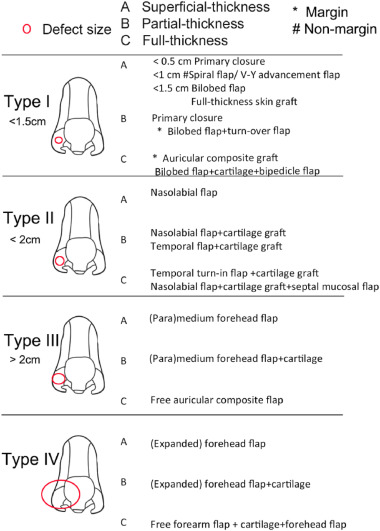Classification and reconstructive options for nasal alar defect in Asians
Published 29 May, 2024
The nose occupies the most prominent part of the face. It consists of several subunits, with the nasal alar being the most distinct and delicate. Alongside other subunits, the nasal alar contributes to the convex and concave contours.
Alar defects may arise from various factors such as trauma, scars, tumor resection, congenital deformity, and, more recently, vascular complications associated with nasolabial fold filler injections, leading to nasal alar necrosis and subsequent defects.
Nasal alar defects in developing countries like China are predominantly caused by industrial trauma rather than Mohs micrographic surgery. Traumatic defects often involve the alar cartilages, crucial structure that act as the supportive framework. Unlike Caucasians, Asians tends to have weaker alar cartilages, making their involvement crucial in evaluating the defect depth. Additionally, Asian patients are prone to hypertrophic scar formation following trauma or surgery, necessitating evaluation of scar formation as a postoperative complication.
In a study published in the KeAi journal Chinese Journal of Plastic and Reconstructive Surgery, a group of researchers from China outlined an accurate classification and systematic treatment algorithm for nasal alar defect in Asians.
“Based on the defect classification system and clinical experience, we introduced a treatment algorithm that provided appropriate approaches for different alar defects.,” explains corresponding author of the study, Danru Wang, a professor in plastic and reconstructive surgery at the Shanghai Ninth Hospital. "A type I defect indicates a small defect with diameter less than 1.5 cm, while A type II defect indicates a medium-size defect with diameter between 1.5 and 2 cm. A type III defect indicates a large defect with diameter more than 2 cm.”
Each type is further subdivided based on the thickness of the defect as superficial thickness (A, involving only alar skin), partial thickness (B, involving alar skin and cartilage), and full thickness (C, involving alar skin, cartilage, and mucosa). Additionally, type IV defect indicates a combined defect involving other subunits such as the cheek or maxilla.
This algorithm is valuable for analyzing the severity of the deformity, and the associated reconstructive algorithm aids in selecting the appropriate surgical approach for each type of defect.

Contact author details:
Department of Plastic and Reconstructive Surgery, Shanghai Ninth People’s Hospital, Shanghai Jiao Tong University School of Medicine, Shanghai 200011, China.
Conflict of interest:
The authors declare that they have no competing interests.
See the article:
Renpeng Zhou, Dongze Lyu, Chen Wang, Danru Wang. Classification and reconstructive algorithm for nasal alar defect in Asians. Chin J Plast ReconstR Surg. 2024;6(1): 22–27. https://doi.org/10.1016/j.cjprs.2024.03.003.